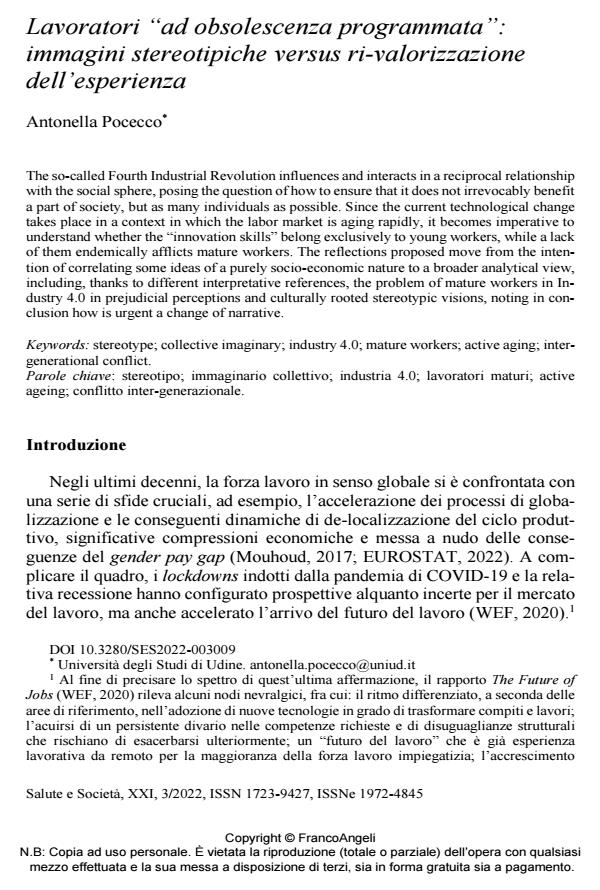Lavoratori "ad obsolescenza programmata": immagini stereotipiche versus rivalorizzazione dell’esperienza
Journal title SALUTE E SOCIETÀ
Author/s Antonella Pocecco
Publishing Year 2022 Issue 2022/3 Language Italian
Pages 13 P. 121-133 File size 408 KB
DOI 10.3280/SES2022-003009
DOI is like a bar code for intellectual property: to have more infomation
click here
Below, you can see the article first page
If you want to buy this article in PDF format, you can do it, following the instructions to buy download credits

FrancoAngeli is member of Publishers International Linking Association, Inc (PILA), a not-for-profit association which run the CrossRef service enabling links to and from online scholarly content.
The so-called Fourth Industrial Revolution influences and interacts in a reciprocal relationship with the social sphere, posing the question of how to ensure that it does not irrevocably benefit a part of society, but as many individuals as possible. Since the current technological change takes place in a context in which the labor market is aging rapidly, it becomes imperative to understand whether the "innovation skills" belong exclusively to young workers, while a lack of them endemically afflicts mature workers. The reflections proposed move from the intention of correlating some ideas of a purely socio-economic nature to a broader analytical view, in-cluding, thanks to different interpretative references, the problem of mature workers in Indus-try 4.0 in prejudicial perceptions and culturally rooted stereotypic visions, noting in conclusion how is urgent a change of narrative.
Keywords: stereotype; collective imaginary; industry 4.0; mature workers; active aging; inter-generational conflict.
- Basu M., Hedrich W., Sung P., Chacko L. (2018). The Twin Threats of Aging and Automation. New York: Marsh & McLennan Companies.
- Bennati R. (2018). Industria 4.0 e WCM. Appunti sul lavoro umano: digitalizzazione globale e partecipazione. In: Cipriani A., Gramolati A. e Mari G., a cura di, Il lavoro 4.0. La Quarta Rivoluzione industriale e le trasformazioni delle attività lavorative. Firenze: Firenze University Press.
- Boudiny K. (2013). “Active ageing”: from empty rhetoric to effective policy tool. Ageing & Society, 33: 1077-1098. DOI: 10.1017/S0144686X1200030X
- Butler R.N. (1969). Age-ism. Another form of bigotry. The Gerontologist, 9(4): 243-246.
- Cann P., Dean M., a cura di (2009). Unequal Ageing: The Untold Story of Exclusion in Old Age. Bristol: Policy Press.
- Capowski G. (1994). Anatomy of a leader: where is the leader of tomorrow?. Management Review, 83(3): 10-18.
- Castells M. (2002). Il potere delle identità. Milano: Università Bocconi.
- Checcucci P., a cura di (2019). Lavoratori maturi e nuova occupabilità. L’innovazione tecnologica 4.0 in due studi territoriali. Roma: Inapp Report.
- Chiesa R., Toderi S., Dordoni P., Henkens K., Fiabane E.M., Setti I. (2016). Older workers: stereotypes and occupational self-efficacy. Journal of Managerial Psychology, 31(7): 1152-1166. DOI: 10.1108/JMP-11-2015-0390
- Cipriani A., Gramolati A., Mari G., a cura di (2018). Il lavoro 4.0. La Quarta Rivoluzione industriale e le trasformazioni delle attività lavorative. Firenze: Firenze University Press.
- De Toni A., Battistella C. (2007). Dall’Homo sapiens sapiens all’Homo technologicus: bioconservatori versus transumanisti. Teoria, 27(9): 91-101.
- EUROSTAT (2022). Gender pay gap statistics. -- Testo disponibile al sito: https://ec.europa.eu/eurostat/statistics-explained/index.php?title=Gender_pay_ (26/04/2022).
- Foster L., Walker A. (2015). Active and Successful Aging: A European Policy Perspective. The Gerontologist, 55(1): 83-90.
- Guglielmi D., Curina F., Chiesa R., Sarchielli G. (2016). Stereotipi nei confronti dei lavoratori anziani e pratiche HR: quali relazioni e implicazioni operative?. Counseling, 9, 1. --Testo disponibile al sito: https://rivistedigitali.erickson.it/counseling/archivio/vol-9-n-1/stereotipi-nei-confronti-dei-lavoratori-anziani-e-pratiche-hr-quali-relazioni-e-implicazioni-operative/ (01/11/2021). DOI: 10.14605/CS91160
- Gullette M.M. (2004). Aged by Culture. Chicago: The University of Chicago Press.
- Gullette M.M. (2018). Against “Aging” – How to Talk about Growing Older. Theory, Culture & Society, 35(7-8): 251-270. DOI: 10.1177/026327641881103
- Higgs P., Gilleard C. (2020). The ideology of ageism versus the social imaginary of the fourth age: two differing approaches to the negative contexts of old age. Ageing & Society, 40: 1617-1630. DOI: 10.1017/S0144686X1900009
- Jenkins H. (2007). Cultura convergente. Milano: Apogeo.
- Lavoie M. (2009). Vieillissement démographique et compétences d’innovation. Relations Industrielles/Industrial Relations, 64(4): 641-661. DOI: 10.7202/038877A
- López-López R., Sánchez M. (2020). The Institutional Active Aging Paradigm in Europe (2002–2015). The Gerontologist, 60(3): 406-415.
- Lowry D. (2022). Aging and the life course. Social and cultural contexts. Lanham: Rowman & Littlefield.
- Mazali T. (2018). From industry 4.0 to society 4.0, there and back. AI & SOCIETY, 33: 405-411.
- Ming W. (2007). Prefazione. In: Jenkins H., Cultura convergente. Milano: Apogeo.
- Mori L. (2018). Le nuove dimensioni del lavoro 4.0 e le sfide per la formazione organizzativa. Un’analisi filosofica. In: Cipriani A., Gramolati A. e Mari G., a cura di, Il lavoro 4.0. La Quarta Rivoluzione industriale e le trasformazioni delle attività lavorative. Firenze: Firenze University Press.
- Mouhoud E. (2017). Mondialisation et délocalisation des entreprises. Paris: La Découverte.
- Neuburger J. (2009). What does it mean to be old?. In: Cann P. e Dean M., a cura di, Unequal Ageing: The Untold Story of Exclusion in Old Age. Bristol: Policy Press.
- Paggi M.E., Jopp D.S. (2015). Outcomes of Occupational Self-Efficacy in Older Workers. The International Journal of Aging and Human Development, 80(4): 357-378. DOI: 10.1177/009141501560764
- Posthuma R.A., Campion M.A. (2009). Age Stereotypes in the Workplace: Common Stereotypes, Moderators, and Future Research Directions. Journal of Management, 35(1): 158-188. DOI: 10.1177/014920630831861
- Silva M.F., da Silva D.S.M., de Macedo Bacurau A.G., Bergamo Francisco P.M.S., de Assumpção D., Liberalesso Neri A., Arbex Borim F.S. (2021). Ageism against older adults in the context of the COVID-19 pandemic: an integrative review. Revista de Saude Publica, 55(4): 1-13. Testo disponibile al sito: https://www.scielosp.org/pdf/rsp/2021.v55/4/en (01/11/2021).
- Timonen V. (2016). Beyond Successful and Active Ageing: A Theory of Model Ageing. Bristol: Policy Press.
- WEF (World Economic Forum) (2020). The Future of Jobs. Report 2020. Geneva: World Economic Forum.
- --
Antonella Pocecco, Lavoratori "ad obsolescenza programmata": immagini stereotipiche versus rivalorizzazione dell’esperienza in "SALUTE E SOCIETÀ" 3/2022, pp 121-133, DOI: 10.3280/SES2022-003009